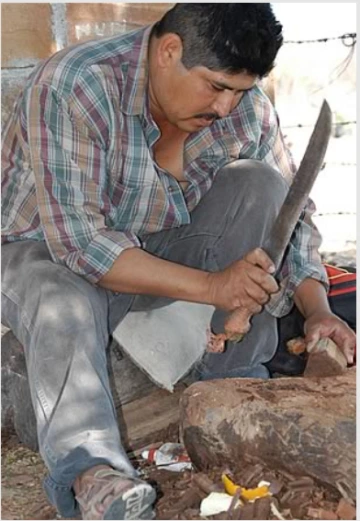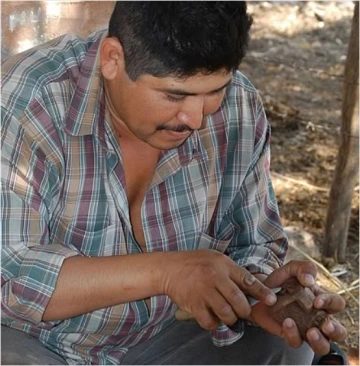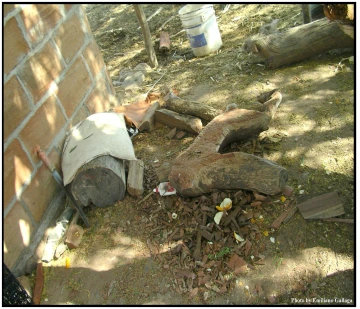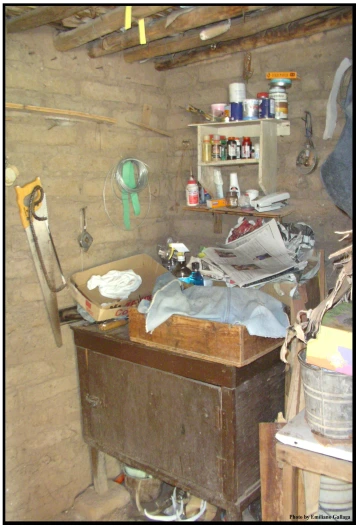The James S. Griffith Collection of Mayo and Yoeme Pascola Masks
The Manufacture of the Mask
The manufacturing of a pascola mask can take between one to two days, depending on the availability of materials, the skill of the maker, the intricacies of the mask decoration, and the maker’s availability of time to dedicate to this task.

Mayo Mask maker, Arnulfo Yocupicio, Masiaca, Sonora. Photos courtesy Emeliano Gallaga.

In the past, Mayo pascola mask production was limited to dancers only. Since the 1960's, an increasing demand from the tourism industry is transforming this industry into a part-time occupation. The workshop or place where mask makers work vary from maker to maker, some only used a nice/cool place to work outside the house under a tree or have a special room for it.

Open area. Photo courtesy Emeliano Gallaga.

Pascola masks are made of wood only, preferably from cottonwood (especially the root), palo joso, Guasima, and torote prieto, although other trees are used as well depending on availability (see Table 3).Common in the Mayo region, these trees are found along the river and in the nearby hills. They are chosen because their wood is soft and easy to work with using just inexpensive sharp tools, such as pocket knives, machetes, chisels, or carpenter’s tools, and simple sandpaper.
| Table # 3: Types of wood used in mask manufacture according to Griffith’s field notes: | ||||
| Griffith’s Notes | Mayo name* | Spanish name* | English name* | Taxonomic name* |
| Alamo root | Aba’aso nagua | Raiz de Álamo | Cottonwood root | Populus Mexicanasubsp. dimorpha |
| Cacaragua (?), (probably Caguorara) | Caguorara | Guyparín (colorin) | Sonoran persimmon | Diodpyros sonorae |
| Chilicote | Jévero | Chilicote, Flor de mayo, Peonía | Coralbean | Erythrina flabelliformis |
| Chukuri Toro | Same as Torote | |||
| Cottonwood root | Same as Alamo | |||
| Guasima | Agia | Guásima | Guasima (elm-like) | Guazuma ulmifolia |
| Josa, (probably Joso) | Joso | Palo Joso | N/A | Albizia sinaloensis |
| Perihuete (?) | ||||
| Plum | Ciruelo | Plum | ||
| Torote Prieto | To’oro Chucuri | Torote Prieto | Black Torote | Bursera laxiflora |
| Utatabe (?) | ||||
* From Yetman and Devender 2002.
Once the desirable shape is carved, makers paint the mask. Already at the time of Griffith's collection, mask makers like today used enamel commercial paint commonly named zapolinas. There is no record of natural colors being used in any quantities within recent memory. However, Francisco Gamez recently won a state of Sonora award for a mask painted with mesquite gum and crushed deer bone mixed with egg whites. And it is not unreasonable to think that the commercial products replaced earlier natural dyes.
On top of the traditional black base color, red and white appear commonly as decorative colors, although other colors are recorded. Again, masks made for tourism diverge from this traditional code and often exhibit greater color diversity, like the pink mask 2005-809-20. Having simply ordered a mask, Griffith received this pink version with good humor as he was told by its carver the mask represented a “gringo pascola” (Griffith 1967a:47). The finishing of the mask ranges from being very coarse to very smooth and glossy.





